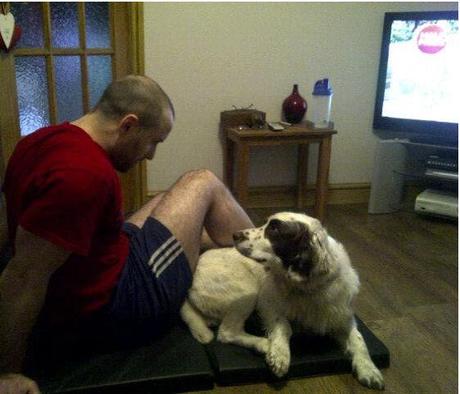If you fail to plan and prepare your new routine, then you are bound to fail!
Getting started and continuing an exercise programme can be a challenging yet rewarding undertaking. Fifty percent of those who begin an exercise programme will drop out with-in six months.
You can implement various techniques to improve your adherence to these new lifestyle changes. Determine where you are going to exercise. Some people find it more convenient to exercise at home. Others may find they have less distractions at an exercise facility. If you choose to exercise at a gym, pick one that is nearby since you may be less likely to exercise at a club that is further away.

stretching foam roller
" data-orig-size="562,482" sizes="(max-width: 562px) 100vw, 562px" data-image-title="Tedmat" data-orig-file="https://seoandmma.files.wordpress.com/2013/12/tedmat.jpg" aperture="aperture" />Sod off Ted, I’m trying to exerciseYou are more likely to stick with your programme if it is fun and convenient. Choose the most convenient time to exercise with the least distractions. Find activities that you enjoy. Your first few workouts should be brief and well within your abilities.
Gradually increase the duration and intensity of your exercise. Do not start out with a program your coach had you perform in high school or college. Individualize your program and begin back gradually.
When working out with a partner try to choose someone with a similar fitness level. As a beginner, you may work too hard if you exercise with an experienced partner. Studies have demonstrated you are less likely to continue your program if you exercise at higher intensities too soon. Likewise, long workouts are also associated with higher drop out rates.
Goal Setting for Exercise Process Vs Outcome Goals
Set realistic goals that contribute to long term lifestyle changes.
Set both process and outcome goals.

A process (or intrinsic) goal is one which is under your control and relates to the behavior required to achieve your desired outcome.
For example, a process goal could be:
Monday, Wednesdays & Fridays at 7 P.M. for 30 minutes.
Outcome goals relate to the desired ‘outcome’. The final result that you want.
Examples of outcome goals include:
Losing 10 pounds by a specific date or jumping 1 inch higher on a vertical jump test by next season.
Make the goals Specific, Measurable, Achievable and Time-phased/bound.
A poor goal would be to write down “I want to lose weight”.
A better goal would be:
I want to lose 4 inches of my waist by December the 15th 2019.
Then break this down into process goals such as:
I will only eat between the hours of 11am and 8pm
I will go to the gym 3 times a week at 7pm.
Focus on achieving your behavior goals since you will have much more control in achieving this type of goal. Do not get discouraged if your short term outcome goals are not achieved by your initial deadline.
Don’t be afraid to re-evaluate your plan if you discover a more effective means to attain your objectives or are not certain you can consistently achieve your behavioral goals.
Commit to Your Goals
Commit to your goals. Initially you may be very motivated to stick to your program. It is not unusual for your motivation to dip occasionally. Discipline and establishing a regular routine will help staying on track.
A good way to commit to your goals is to write them down and then sign at the bottom stating that you will take ‘ownership or your goals and commit to them completely’. If you’re feeling really brave, you can share a picture of your signed goals on social media.
Participate in physical activities with your spouse, family, or friends. Be creative. Every week take turns having family members choose their favorite family activity. Share your goals with those close to you or others that are likely to ask you about your progress. Ask them for their support. Having explained that you have set aside a particular time to exercise can potentially minimize future conflicts or misunderstandings.
Those close to you will have the opportunity to understand the importance of your goals and the time you have set aside for them. Write your goals on paper and post them where they are in view for you to see every day (e.g. refrigerator, mirror, date book, etc.). Some people may even find it helpful to sign a personal fitness contract with their personal trainer or friend.
If you feel like not working out, agree to yourself to have a very short, light workout. Quite often, after getting ready and warming up, you will find enough motivation to push through a full workout.
You Don’t Need a Gym – Make Physical Activity a Lifestyle
You don’t necessarily need to go to the gym or to an exercise class. Perform a variety of exercises and activities. Engage in utilitarian activities such as walking to the store, walking the dog, or catching up on yard work. Try new activities you think you may enjoy.
Learn about these new activities by reading an instructional book, watching instructional videos or documentaries (this can be very motivating), by joining a training group, or hiring a personal trainer.
When walking, jogging, or cycling, vary exercise routes or trails. You might find it helpful to use diversions such as listening to music, watching television, or reading during exercises that you would otherwise find a bit boring.
If possible, utilize social support. Find an exercise partner, hire a personal trainer, or exercise in a group setting. A training partner or exercise instructor can provide feedback, assistance, and motivation.
Monitor your progress
It can be motivating to see your progress. Record your activity and progress in an exercise diary or log. You can even record your diet in a journal or a food exchange check list. Consider purchasing an electronic monitoring gadget like a pedometer, heart rate monitor, or stop watch to track your progress.
If finances allow it, you could find an exercise professional who can monitor your progress for you. Regular fitness tests can objectively measure the effectiveness of your program and can possibly save you months or even years of hard work. If progress is not significant, immediate changes can be made to your program. A fitness professional can help you decide the tests most compatible with your fitness goals and how often you should test.
Although some individuals may thrive on competition, many beginners may get discouraged when they compare their fitness levels and abilities with others. Comparing yourself to others may bring about either disappointment or conceit. Remember, it is not so important where you are today as it is where you will be tomorrow. Certainly you do not need to implement every strategy outlined in this article.
Anticipate Obstacles & Hurdles
Common obstacles include:
- Being offered sweets & unhealthy food in work
- People making passive-aggressive comments about being on a diet
- Feeling too tired to go to the gym
- Your training partner giving up
- Struggling for time
- Being demotivated by lack of progress
Make sure you have a strategy in place to cope with each of the above possibilities. Take ownership as well – don’t blame a friend or family member if you fail to adhere to your plan and reach your goals!
This video may help with the ownership thing:
Summary
Have a specific plan in terms of the process – where, when, how often etc.
Set specific process & outcome goals
Take ownership of your goals
Predict obstacles & hurdles that must be overcome & plan for them

